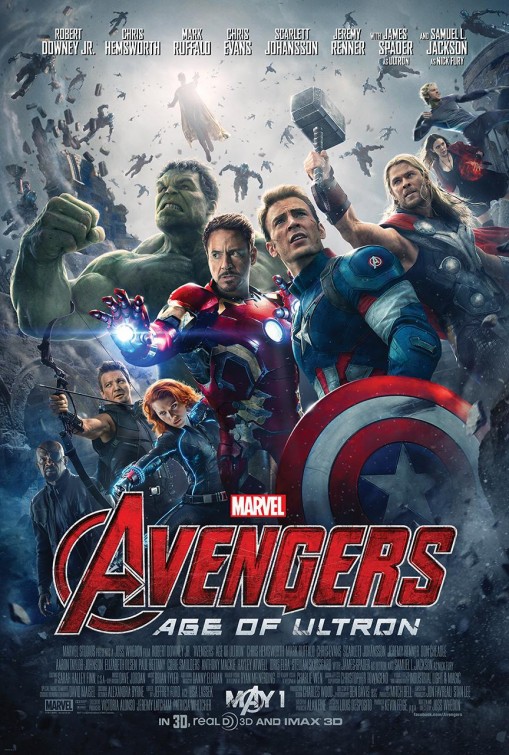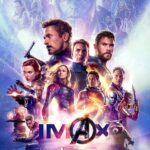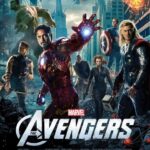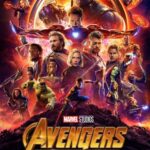A New Age Begins
Director
Joss Whedon
Starring
Robert Downey Jnr.
Chris Evans
Chris Hemsworth
Jeremy Renner
Mark Ruffalo
Scarlett Johansson
James Spader
Only a month ago, the public were at fever pitch in anticipation of the release of an Avengers sequel, not to mention the media and box office speculators predicting a record breaking release of monumental proportions. Then the full trailer for the rather troubled Ant-Man was uploaded and while it did its job, an air of concern hung over it; would this be Marvel’s stumbling block? Their first release to falter and cast doubt over their unstoppable reign? Curiously enough, no. The first signs of stumbling are in fact discreetly concealed in this release in an unexpected form: its progenitors wanting out. As with most of my reviews, these critical breakdowns are intended to be read after viewing the film. Meaning that this analysis is going to be a thoroughly spoiler-filled ruination, so if you have yet to see the film for God’s sake don’t read this yet. Got it? Good, now we’ve got that out of the way, we have a lot to discuss.
The story opens with a major operation to recover Loki’s sceptre (as seen in The Avengers) from HYDRA agents. During this skirmish, Iron Man/Stark [Downey Jr], Captain America/Rogers [Evans], Thor [Hemsworth], Black Widow/Romanoff [Johansson], Hawkeye/Barton [Renner] and Hulk/Banner [Ruffalo] encounter the super-powered Maximoff twins (Quicksilver/Pietro [Taylor-Johnson] and Scarlet Witch/Wanda [Olsen]) but eventually win the day, making off with the sceptre. Stark has his mind tampered with by Wanda and feeds his paranoia of another alien invasion. This fear inspires Stark to act rashly, in the name of science, and experiment on the artificial intelligence lying within the crystal at the centre of the sceptre. This intelligence, Ultron [Spader], becomes self-aware and immediately deems mankind unworthy of existence.
As obvious as this may sound, writers work through their own emotional hang-ups and issues through scripts. Feeling maudlin or mourning a loss? It’ll come out in your next script. Got married, had a kid and prospects are looking up? It’ll play a pivotal role, either with its positivity or exploring the potential loss of said happiness. Now, if you’re also acting as producer and director these subtle elements aren’t treated lightly, they’re brought to the fore. Meaning whatever Joss Whedon’s been going through these last few years is going to translate to the most important element of the script. “Bad guy threatening global domination? Not my problem. Sure I’ll deal with that stuff but really, I’ve got something I want to say and if I don’t get this out, it’s going to cripple me.” If you don’t believe me, just check out Whedon’s directorial history. What did he do immediately after Avengers? A small black and white adaptation of a play that was shot over a few days.. in his own house.. with his friends. And the message throughout Age Of Ultron is that big budget blockbusters are not Whedon’s preferential forte and given a choice, he’d use the success as a springboard for quieter, intimate independent releases. In a way, the film benefits immensely from this, ensuring that character development and the emotional core is at the very centre of the story, rather than muscly people punching each other without cause or reason – unfortunately, when we get to the punchy sections there are a few plot holes and issues that feel like someone stepped in and murmured, “Joss, it’s been ten minutes since someone got into a violent confrontation, can you sort that out? Thanks” and his response was to simply spin a few bridge scenes and suddenly action happens.. just because. The differences between Avengers and Age Of Ultron is less The Godfather and The Godfather: Part II (as was both heavily predicted and promoted) but more The Godfather and Apocalypse Now. Everything about this movie feels tonally different from its predecessor and despite all the returning elements, seems to get lost in its own mad, out of control, ever-expanding universe. Whedon’s got a great eye for satirical analysis and incorporating that into his work extremely effectively without coming off as heavy-handed. But rather than satirising or analysing terrorism, the United States’ place in the modern world, rumblings with Eastern Europe or anything else taking place in the real world, Whedon’s whole existence these past few years has been Marvel, so the only thing he can explore and critique is what it’s like to work for Marvel. This injection of personality serves to not only strengthen and justify the action but also acts like an anchor, weighing everything else down and when life gets in the way of art it both heightens and taints it. Thus what started out as a big interesting project, quickly spirals out of control and you realise your own creation is a monster and if you don’t get away it’ll eventually kill you but it’s better than anything anyone else is doing, so maybe that self-sacrifice is necessary – hence Apocalypse Now.
While we’re on the subject of comparisons, drawing hasty parallels with The World’s End and The Dark Knight Rises would be both a disservice and maybe a little inaccurate as both of those films felt like obligatory instalments that the respective cast and crew were expected to release but never really exceeded the achievements which preceded them. But again, these are trilogies we’re referencing, Marvel has created a cross-over franchise we’ve never truly seen before in cinema and fittingly, the only comparison we can accurately draw is that of either comics (obviously) or soap operas. The story never ends, it just keeps ticking over with the same faces until those involved are so typecast or battered from the schedules that they simply find a way to awkwardly kill off the character – only to resurrect them later either with a different actor or a clumsy plot device which people contest thirty years after the fact. The only cinematic equivalent that even comes close is the James Bond franchise – we all know the leads will survive and that the bad guy will be thwarted, everyone else is expendable and most of the new faces are hints at future franchises. Both James Bond and the serials of the 30’s and 40’s understood a very clear premise: It’s not if he escapes, it’s how he escapes. A fact Marvel is all too bogged down with thanks to future releases already confirming that the central cast will survive no matter how high the stakes because they are contracted to appear in various sequels. But the spectacle must increase, the audience demands it. There’s a terrifying unquenchable thirst in us and like a growing receptacle that must systematically be replenished, we greedily always want more. But if you can’t kill off the leads what do you do? Introduce an endless stream of supporting characters, some who continue on in their own right and others who are simply fodder, which eventually means future introductions without their own spin-offs are hard to connect with. The term for these characters is Bond girls. To any artistic talent, that’s incredibly daunting. Knowing that everything you do will be held up against both past and future works, that every genius idea, great performance or clever shot will sooner or later need to be matched and superseded? It’s crushing. But in all honesty, we hold Marvel to a very high standard. With other action films and big summer blockbusters you try to retain an optimistic outlook and make several excuses to justify the faults and flaws (the brush every review for future DC films will no doubt be painted with). But Marvel is like any well-established creative; you don’t compare Picasso to Turner, you compare a Picasso composition to another Picasso composition and as such we’re much more critical and unforgiving. Which is my way of saying all of the above may seem like a damning weight pinned against this pitiful embarrassment of a release when in actuality I’m looking at the Mona Lisa after its first unveiling, frowning and saying, “You missed off the eyebrows.”
As previously stated, this film is packed with subtext and one of the principle overriding themes is the monsters we create: Banner and Hulk, Stark and Ultron, the KGB and Black Widow, Hydra and the twins, Ultron and Vision, Whedon and The Avengers; all creators of their own undoing or at the very least, something that has brow-beaten them out of a normal existence. As such, the key elements of Frankenstein continually pop up with references to evolution and change – a narrative precursor, prepping the audience for the notion that the roster of their favourite characters will morph into something different from film to film and this is something which should be embraced rather than feared, even if it does seem scary and uncomfortable. But with the inclusion of Hawkeye’s secret family, we also see the positive side of the Frankenstein story, the desire to create something better, a brighter future and a reason to fight in the first place. Not to mention one of Hawkeye’s monologues effectively stating he loves his job but it’s still a job. The only character that doesn’t seem to fit into this whole Shelley/Whedon agenda is Captain America. Cap doesn’t have anyone really (Peggy is deeply afflicted by dementia, Bucky’s a brainwashed assassin and almost everyone else is dead), his purpose is the cause and he was literally built for this; which is probably why whenever characters bring up the nature of protection, Cap is the only one who devotes himself wholly to it – much like the Nick Fury character but with a more powerful moral compass.
Subtext aside, let’s actually look at the characters. The central team of the Avengers have undergone a bit of a shuffle. Hulk, Hawkeye and Black Widow (we’ll call them the non-standalones) have a fair amount of runtime devoted to their personal development and the respective performances are just as strong as ever. Admittedly, the ‘relationship’ between Banner and Romanoff feels a little unfounded but it’s given a very emotional and realistic treatment, justifying its existence, rather than simply randomly pairing up colleagues. Then we have the franchise pillars: Iron Man, Thor and Captain America. Thor gets shafted the most, missing for a large chunk of the story just to appear later with a heavy amount of franchise exposition – what I like to call the Gandalf method – but even this feels like a setup for Thor: Ragnarok. And Stark and Rogers are boiled down to more precursor spatting which will eventually explode in Captain America: Civil War. What about the new additions: Vision, Scarlet Witch and Quicksilver? The choice to merge JARVIS and Vision is frankly inspired and with Paul Bettany now playing a live-action role, rather than just a voiceover element, it feels like a character evolution that’s been a very long time coming (from the first Marvel film in fact). Secondly, the twins were very well acted. Wanda’s magical powers open the door to a new visual dynamic from the largely melee-heavy aesthetic of the last film and Pietro’s brash personality and lightning fast speed were brilliantly handled (and thankfully different from the X-Men: Days Of Future Past counterpart), the chemistry between the two is nice but the choice to kill Pietro was a bit sloppy. Which brings me to my next point of contention: death. The Marvel cinematic adaptations have adopted a fair amount of structural framework from their print origins and equally so have adopted some of the problems. Over the last twenty years in comics, death has become a bit of a joke. Characters die only to be reborn in a new series months later. Up until this feature (unless they make a massive 180) Marvel Studios have done the exact same thing, supposedly killing off characters, only to pull back the curtain and reveal they survived somehow. Except for Quicksilver. For some reason Quicksilver is the one character they’ve decided is going to die and stay dead. Why? Who knows. Contract reasons, franchise commitments, could be any number of reasons but ultimately he died and I was bloody annoyed – primarily because I knew Quicksilver would bite the bullet because he’s one of the only characters not locked down for multiple appearances. Admittedly I thought he’d die saving Wanda but whatever, close enough. It ruins the suspense of death but we’re still expected to sit through the perfunctory faux-drama of wondering if Captain America, Black Widow or Hawkeye will die before they’re all set to appear in Civil War this time next year.
With the writing and acting dissected more than enough, let’s take a quick look at the technical aspects. One of my main bitching points with the entire Marvel Cinematic Universe (wondrous though it may be) is that the scores are very lacklustre. Granted, we got a few decent stings from Iron Man 3 and Guardians Of The Galaxy and after a while the Avengers’ theme really grows on you but it lacks aural continuity. The hybrid medley of Tyler, Silvestri’s previous work and Elfman’s additions is just a bit messy. Themes battle for attention and ultimately get lost in the fray and every single time, the film as a whole suffers. The fight choreography was impressive, utilising the vast cast and army of generic baddies well enough that each separate conflict is identifiable and unique, playing to the character’s strengths – much as it was successfully used in The Avengers. I maintain (and will until my dying day) that 3D is not the future of cinema, it’s not like the advent of sound and colour films, it’s just a gimmick that adds a little to the immersion and a lot to the ticket price; so no need to really talk about its effectiveness or otherwise. The CGI, on the other hand, was satisfactory. For the amount utilised, from tiny little holographic projections, to an entire city being levitated into the upper atmosphere, it’s exceptionally impressive but it’s still laced with that uncomfortable layer of disbelief that audiences are wowed by but know it’ll look fake and dated in less than ten years. I imagine people thought the same thing about stop-motion in the 1950’s… maybe not. But at least the visuals were bright. Say what you want about the dreary tone or the sombre attitudes, Age Of Ultron is a film of several palates and colours, clear enough to see, follow and enjoy. And in an age where everything is desaturated to hell and contrasted up through the roof, this is a nice welcome exception.
Avengers: Age Of Ultron is by no means a bad film but it lacked the enjoyment factor that The Avengers projected so well. And I don’t mean it’s too moody, the seriousness is a positive mature direction but something felt amiss, something I can’t quite place my finger on. Something that I believe exudes from a director. Whedon’s put everything into this movie but his heart. To quickly explain, I’m in no way accusing Whedon of not trying or phoning it in, merely reiterating the point I’ve made above; he doesn’t seem to enjoy the slog as much as he did. Like a Christmas party after a death in a family of amnesiacs, something feels missing but nobody can seem to explain what it is.
Release Date:
24th April 2015
The Scene To Look Out For:
There are plenty of really great standout scenes, emotional exchanges, entertaining physical feats, witty wordplay but I think I was most amused and pleasantly surprised by something much simpler. The Vision is ‘born’ and explains to the team that he isn’t on any particular side, a true agent of the cause over personal agenda. Throughout his speech, he earnestly explains to the group that he can be trusted and will do what is right. All of this is cemented so succinctly (not to mention tying up the very publicised Mjolnir trials) when Vision casually hands Thor his hammer, stating they should get to work. It shocks the group and immediately confirms to the audience everything that the character already said. And one of the finest staples of clever writing is to convincingly show a character’s intentions as well as explain them. This simple action does all that.
Notable Characters:
James Spader is a brilliant actor and his performance more than shines through in this film. Playing the role of Ultron, Spader elevates what could easily have been a mishandled villain into a very sympathetic character. Sure, the whole ‘robot decides humanity is the cause of its own suffering’ bit isn’t exactly anything new but in fairness, Ultron’s been around since the 60’s. Physically imposing, tenderly acted and thankfully very funny, it’s almost a shame to witness his eventual demise in the film’s denouement.
Highlighted Quote:
“Go to sleep, go to sleep, go to sleep”
In A Few Words:
“A sequel with brilliant potential that suffers from a touch too much over-stuffing”
Total Score: 3/5
![The Red Right Hand Movie Reviews [Matthew Stogdon]](https://reviews.theredrighthand.co.uk/wp-content/uploads/2021/12/cropped-header1.png)




